2025 State of the University
President Eduardo Peñalver delivered the following remarks at the 2025 State of the University.
/76x0:1205x720/prod01/channel_34/media/seattle-university/who-we-are/leadership/office-of-the-president/0-SOTU.png)
A defining element of Ignatian spirituality is its attention to context
April 25, 2025
So I would like to begin this year’s State of the University by taking a moment to acknowledge the context in which we are gathering.
Along with Catholics around the world – and with all people of good will – we are grieving the loss of our Holy Father earlier this week.
Pope Francis’s deep pastoral warmth has been a blessing to the Church and to the world. His good cheer – his tireless smile – has been the perfect match for our troubled times. “Hard times may come,” he said, “when the cross casts its shadow, yet nothing can destroy the supernatural joy that . . . brings deep security, serene hope and a spiritual fulfilment that the world cannot understand or appreciate.” “Ill humor,” he admonished us, “is no sign of holiness” or righteousness.
Francis’s profound humility and personal sanctity stood in quiet contrast with so many other world leaders who strutted across the world stage during his twelve years as pope.
As the first Jesuit to hold that office, his emphasis on the importance of caring for our common home and for those on the margins echoes the priorities of the Society of Jesus and has set the tone for Seattle University and for Jesuit higher education as a whole.
His legacy includes his many writings, especially his encyclical Laudato Si, which will continue to inspire our work for years to come.
In addition to the loss of Pope Francis, our context also includes the most challenging climate for American institutions of higher education in at least half a century.
At least.
The current administration in Washington, D.C. has made no secret of its desire to exert unprecedented control over American universities, public and private.
To be sure, some change in higher education is certainly justified, or least worth discussing.
But this administration has attempted to assert itself, not through normal rulemaking and enforcement, but rather through executive orders and the aggressive and peremptory use of federal funds as leverage for dictating university policy and practice on issues ranging from academic priorities to student discipline to the treatment of trans people to efforts in pursuit of diversity, equity and inclusion.
Earlier this year, the interim U.S. attorney in Washington, D.C., threatened not to hire any graduates from Georgetown Law School unless it promised to stop practicing DEI or even teaching about it in the classroom.
And we have all seen what has been happening to Columbia and Harvard.
The effort to expand the scope of federal executive power goes well beyond the world of higher education. It extends to other institutions that form the underpinnings our constitutional democratic system.
It includes law firms – among them Seattle’s own Perkins Coie – which the president has targeted for punitive action because he objects to their clients and to legal positions they have taken in representing their clients.
The administration has also targeted vulnerable individuals, particularly foreign nationals. Some of these have been detained for engaging in expressive activities, such as last spring’s protests over the war in Gaza. Others seem to have been targeted for minor legal transgressions. One student appears to have lost his immigration status for fishing without a license.
As if all this were not enough, down in Olympia the state legislature yesterday voted for draconian cuts to the state college grants that provide essential support for our neediest students, but it only cut the grants for those students who choose to attend private universities.
Any one of these challenges would be enough on its own. But, considered together, they achieve a kind of critical mass.
Although many of the actions I am describing are the product of the political process, expressing concern about them is not a partisan act.
As the conservative New York Times columnist David Brooks recently put it, what is happening to universities and law firms and foreign nationals is “an assault on the fundamental institutions of our civic life, things we should all swear loyalty to — Democrat, independent or Republican.”
Some universities and law firms have tried to negotiate in the hopes of avoiding the worst of the threatened consequences. Others – like Perkins Coie and Georgetown Law School and Harvard – have firmly resisted the intrusive demands that have been made of them.
What are we doing here at Seattle University?
As a Jesuit university, before all else, we are caring for our students.
When the administration indicated its intention to bar trans people from serving in the military, we immediately made clear that we would honor the ROTC scholarship of a Seattle University student who is impacted by that ban. Through this action, we intend to send a clear message that we honor the inherent human dignity and right to flourish of our trans students, as well as faculty and staff.
For students threatened with deportation, we have provided “know your rights” trainings and legal consultation and referrals through our law school clinics.
When the government canceled student visas without notice to the affected students or to the university, we began manually searching immigration records on a daily basis so we could let students know if their status suddenly changed, affording them an opportunity to seek legal redress where that is available. (I learned today that at least one of our impacted students has had their immigration status restored.)
For all our students, we are continuing to provide mental health and spiritual support through our Counseling and Psychological Services and through Campus Ministry.
These are just a few of the specific things we are doing.
But let me step back.
In moments of uncertainty and instability like these, it becomes even more important to remind ourselves of our institutional goals; our most deeply held values.
What are those goals and values?
We understand Seattle University’s principal goal as a Jesuit, Catholic university to be providing the highest quality education for all our students and making that education accessible to those who have historically been, and continue to be, excluded from the opportunities afforded by higher education . . . and not just a technically excellent education, but an education that also instills a sense of real purpose.
As our mission statement affirms, we seek to empower our students to become leaders for a more just and humane world, people for and with others.
This mission requires us to focus relentlessly on building and sustaining the excellence of our academic program, which is the basis for the opportunities we want our graduates to enjoy.
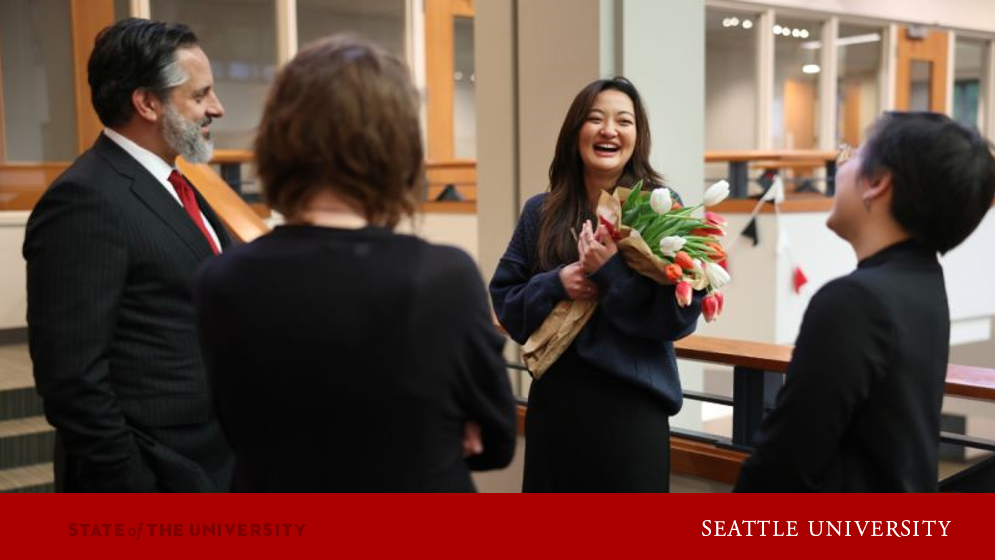
We continue to find success on this front. I am delighted to share with you that one of our students – Naho Umitani – recently received a Truman Scholarship, making her one of just 54 scholars selected this year from over 700 applicants across the country.
To sustain an environment that supports this kind of academic achievement, we need a campus culture that safeguards the fearless search for truth, wherever it leads.
That culture in turn requires academic freedom for our faculty as well as freedom of expression for faculty and students alike, even when they express ideas that are unpopular or controversial.
Our mission of providing the highest quality education for everyone also means creating and sustaining an academic community that mirrors the rich diversity of our democracy and our planet, a global community in which people of all identities, backgrounds, experiences, and viewpoints can flourish and feel welcome.
These core values of excellence and inclusion guide us in all we do.
They should be uncontroversial.
And yet we find that – in our present context – they have become controversial.
As we survey the world around us, including on campus, we see people selectively deploying the language of academic freedom and freedom of expression to favor their ideological allies but to suppress the expressive freedoms of those with whom they disagree.
People who – just a few short years ago – were decrying the narrowness of freedom of expression on campus are now celebrating the detention of foreign students for engaging in lawful protest.
Politicians who – until just recently – were professing concern about free speech are applauding the use of the awesome power of the government to suppress the discussion or promotion of diverse and inclusive campus communities – what they derisively call “DEI.”
In the face of this challenging context, Seattle University remains committed to academic freedom and freedom of expression, regardless of viewpoint or identity.
For some, our commitment to maintaining a diverse and inclusive campus community should override our commitment to welcoming a diversity of perspectives on our campus, leading us to silence or suppress points of view that create discomfort.
This is a false choice that seeks to pit our core values against each another.
If we want to educate our students to become leaders of a diverse, pluralist democracy, leaders who can bring us back from the binary thinking of pernicious polarization that is tearing our country apart, we need to interrupt the intellectual habits that feed polarization.
And we can’t do that if our commitment to radical hospitality does not extend to those who disagree with us, or if our campus community does not reflect the diverse perspectives of our democracy.
Although this can create discomfort, we can’t prepare our students for life and leadership in a society plagued by political polarization and disagreement if we train them within a protective cocoon or – even worse – an ideological echo chamber.
To accomplish our educational goals, we need diversity of identity, diversity of life experience and diversity of viewpoint. And then we need to couple those diversities with what Pope Francis called a “culture of engagement.”
Each of these values is non-negotiable.
We will respond to the rapidly changing legal landscape in ways that reflect and affirm them.
In some cases, and in the best Jesuit tradition, this may require finding creative new ways to achieve our unchanging goals consistently with the law.
In others, it may require us to assert our Constitutional rights of religious freedom.
But in all cases, and following the model provided to us by the Jesuits over the centuries, we will face our context with courage and conviction as well as wisdom and creativity.
This leads me to the most powerful way we can respond to our challenging times: by continuing to look to the future with a spirit of hope and optimism – by continuing to take bold action to move Seattle University forward.
As a Jesuit, Catholic university, we are called to be a community of faith, hope, and – above all – love.
And, as the first letter of John reminds us, “there is no fear in love.”
The most frequently repeated phrase in the Bible is some version of “do not be afraid,” a phrase we hear a great deal during this Easter season.
When we act out of fear, or find ourselves paralyzed by it, we are failing to live out our Jesuit, Catholic mission.
No good decision is ever rooted in fear.
I am reminded of the “Parable of the Talents” from the Gospel of Matthew.
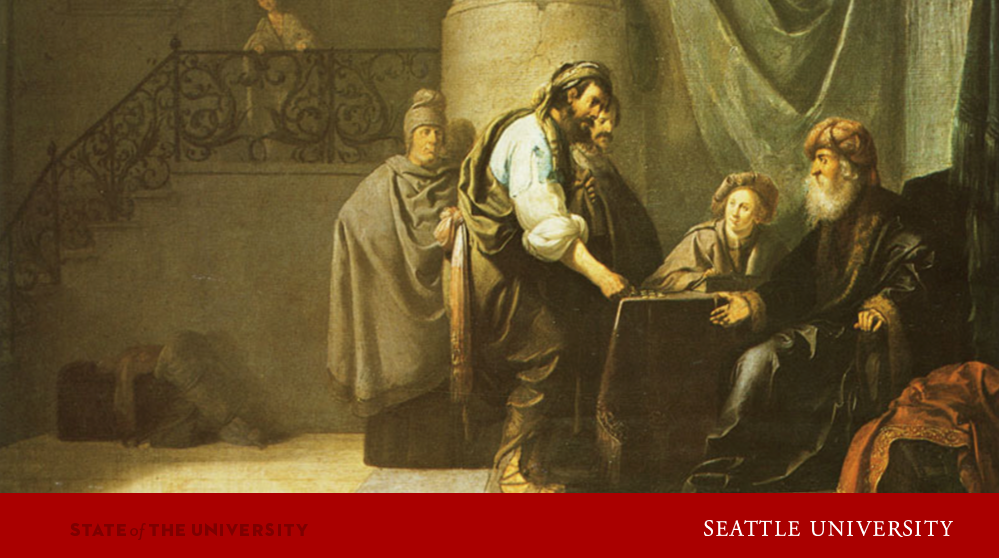
In that story, a master – who stands in for God – is leaving for a long journey. Before he departs, he entrusts large sums of money to each of three servants.
The word the Gospel-writer actually uses for these sums of money – the “talent” – is an ancient unit of monetary measurement that is the origin for our modern word, “talents.”
Commentators attribute that shift in meaning of the word “talent” from a unit of money to its modern meaning as “abilities” or “gifts” to the influence of this very Gospel story.
When the master returns after a long time away, he finds that the first two servants have boldly invested the money (the “talents”) he entrusted to them. They each return to him double what he gave them.
Needless to say, he is pleased.
But the third servant simply returns the amount he was given.
“Master,” he explains, “I knew you to be a hard man, reaping where you did not sow, and gathering where you did not winnow; so I was afraid, and I went and hid your [talent] in the ground. Here you have what is yours.”
The master’s judgment of the fearful servant is immediate and unsparing. If you knew I was a hard man, he says, you should have at least invested my money with the bankers, so I could have had it back with interest.
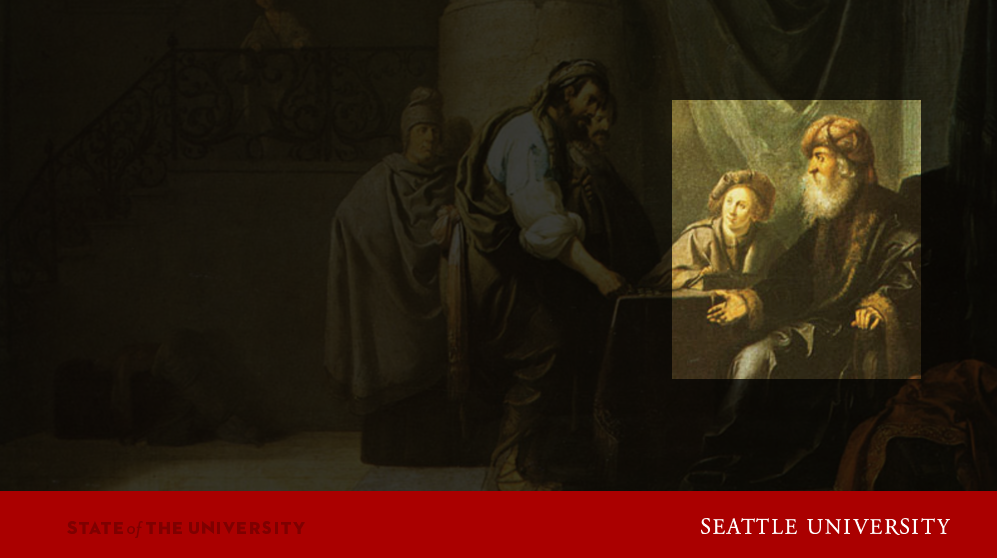
I love how the 17th century Dutch painter, Willem de Poorter, depicts the unhappy master’s reaction. (If Pat Callans ever looked at me like this, I think I would be tempted to pack my bags.)
We have – all of us – been entrusted with an incredible treasure in the form of Seattle University, an institution built brick-by-brick over generations by countless Jesuits and lay people during our 130 years; through good times and hard times – through two world wars, a great depression, the urban strife of the 1960s; through financial crises and a global pandemic.
In our own times, we can choose to fearfully bury that treasure in the ground; or we can continue to prepare Seattle University for the future, to face our own hard times with courage and creativity.
The lesson I take from the Parable of the Talents is that we cannot succumb to fear. We have an obligation to take the many gifts we’ve been given and to cultivate and grow them for those who come after us.
That is what we are doing at Seattle University.
And so I will conclude my report on the state of our university with a few updates about exciting initiatives we are continuing to pursue, even in these very uncertain times.
Last year, shortly after our last State of the University, we achieved a goal that has been decades in the making – our return to the West Coast Conference – the athletic conference we helped to found . . . the home of our west coast Jesuit peers (well, now our west coast Jesuit peers minus one).
We look forward to celebrating our official transition to the West Coast Conference on July 1. Please be on the lookout for announcements as we mark that transition in the coming months.
Throughout this past fall and in the first few months of 2025, we have also been hard at work to establish the Cornish College of the Arts at Seattle University.
Last month, we announced that our board of trustees approved a definitive agreement with Cornish to launch that college.
When the agreement closes, which we expect to happen on May 31, Cornish will contribute its assets to Seattle University and then wind down.
We will help to preserve the 100-year Cornish legacy by immediately launching the Cornish College of the Arts at Seattle University, which will operate on Cornish’s South Lake Union campus and at the Cornish Playhouse at the Seattle Center.
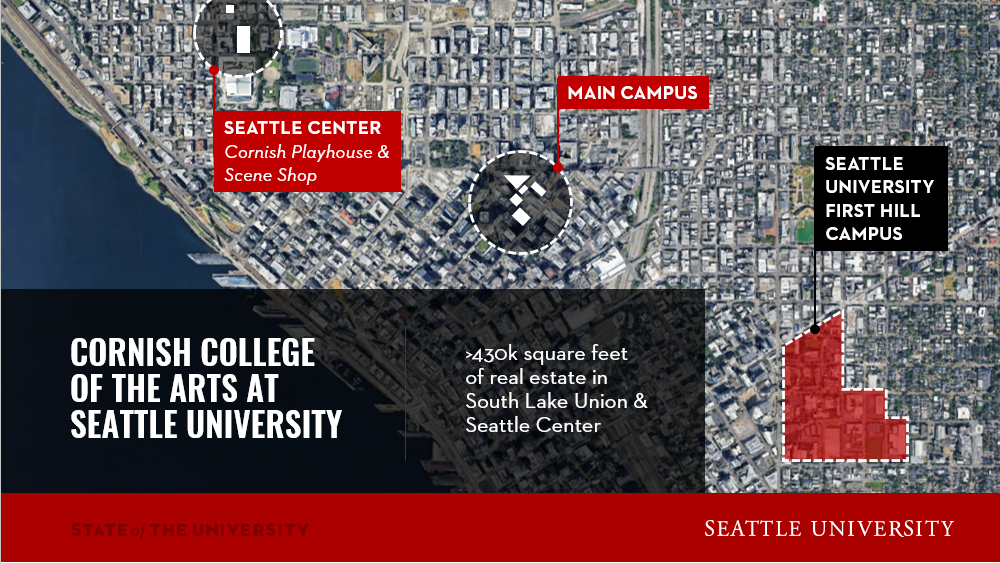
Current Cornish students will be able to complete their programs with Seattle University, continuing to study in the same facilities, with the same curriculum, and with most of the same faculty and staff, most of whom we will be hiring as Seattle University employees.
Cornish students will also enjoy the opportunity to be part of a comprehensive university, with the many academic, social and programmatic opportunities that represents.
For Seattle University students, the creation of the Cornish College of the Arts at Seattle University will constitute a dramatic, almost ten-fold expansion of our offerings in the visual and performing arts, including innovative interdisciplinary programs like Game Arts and film production.
For Seattle University, this move also represents a generational expansion of our institutional presence within the City of Seattle.
Operating on multiple campuses will be a significant change for students, faculty and staff at both institutions. This will stretch us.
But this is a common reality for urban Jesuit universities. Georgetown and Fordham have two campuses, several miles apart. Loyola Chicago has three campuses.
Detroit Mercy has four.
We need to navigate this change with thoughtfulness and care, but I am confident that the creation of the Cornish College of the Arts at Seattle University will be a major step forward for both schools.
It dramatically advances our ambition to be Seattle’s university – the premier private university in our region.
Years from now, I predict we will struggle to remember how we ever existed without Cornish and its South Lake Union campus, just as we can no longer remember how Seattle University existed without a law school.
Among the many things that the Cornish College of the Arts brings to Seattle University are a diversity of new performance spaces.
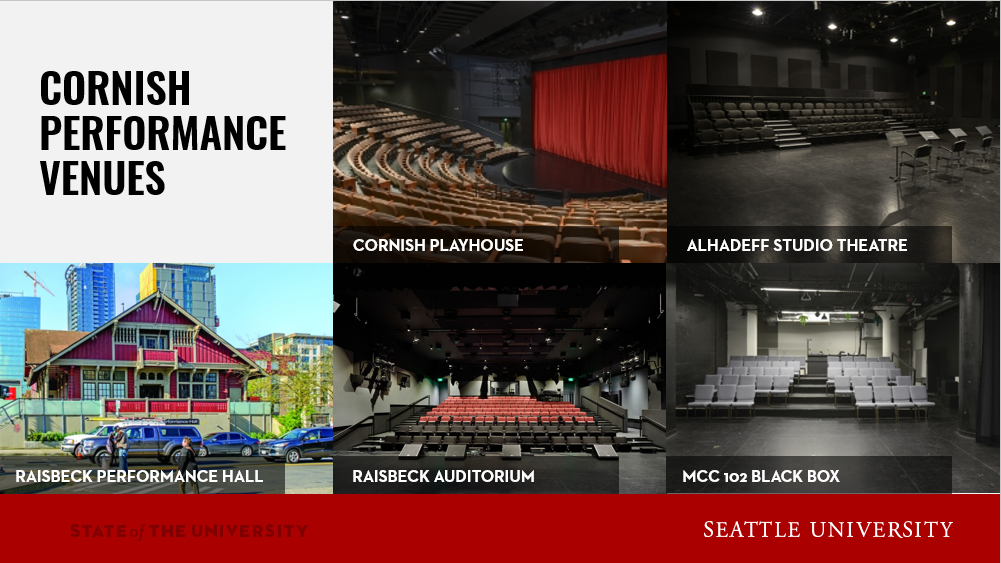 The consolidation of our offerings in the visual and performing arts on what we will call Seattle University’s South Lake Union campus will mean significant changes for our First Hill campus.
The consolidation of our offerings in the visual and performing arts on what we will call Seattle University’s South Lake Union campus will mean significant changes for our First Hill campus.
Specifically, it will mean changes in how we use spaces on this campus, including the Lee Center for the Arts, which is located on the northwest corner of Marion Street and 12th Avenue, across the street from the Sinegal Center for Science and Innovation.
Last summer and into this fall, with the help of an external consultant, we carefully examined those likely changes as we evaluated numerous possible locations for the new Seattle University Museum of Art in light of our campus master plan.
This cutting-edge teaching museum will house the $300 million art collection given to Seattle University by Dick and Betty Hedreen, an historic gift that I discussed with you at last year’s State of the University, the largest gift of art ever received by an American university and the largest single gift ever given to a university in the State of Washington.
Our site-selection evaluation was occurring at the same time that we were beginning our conversations with Cornish. As those negotiations became more promising, the strong recommendation of both our consultant and our architect, Tom Kundig, was that we should locate the museum on the site presently occupied by the Lee Center.
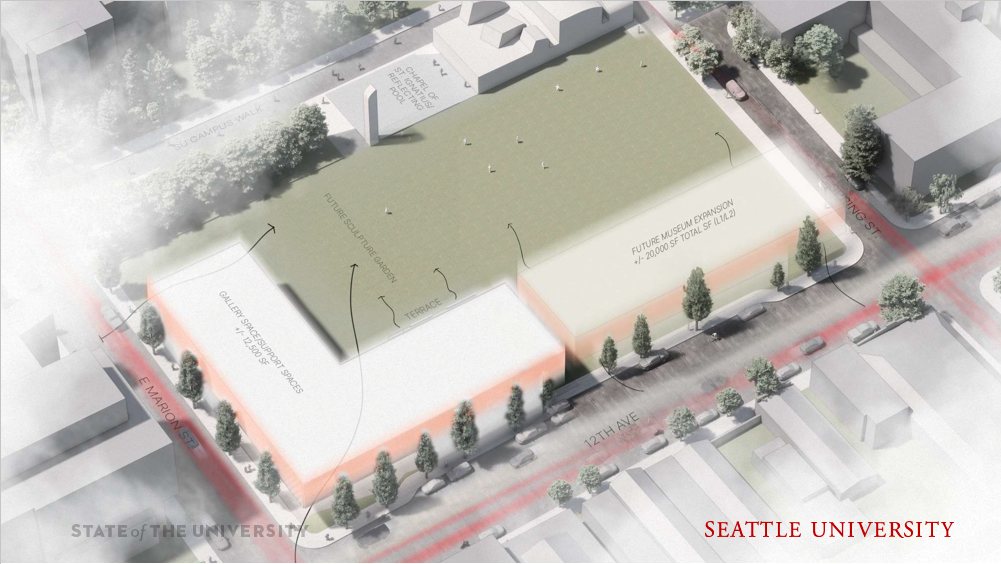
The movement of our performing arts to South Lake Union meant that the Lee Center will no longer host our theater program.
This change creates the opportunity to build a dramatic and aesthetically compelling entrance to our First Hill campus, one that enhances the architectural impact of the award-winning Chapel of Saint Ignatius and that completes the site plan first envisioned 25 years ago by Father Bill Sullivan and the architect Steven Holl.
I am excited to share with you an early rendering of what that museum will look like, once it is built.
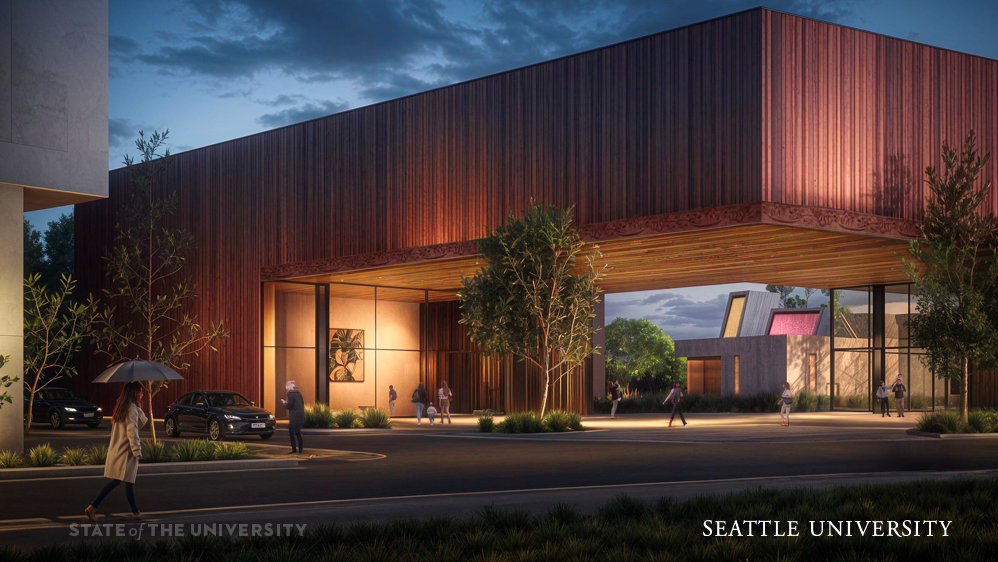
We continue to raise funds for this project, which – once complete – will become a new Seattle landmark.
We plan to break ground in the summer of 2026.
A final way that we are boldly pursuing our future is by planning for our next campaign.
Our VP for Advancement Edgar Gonzalez, gets really nervous every time I talk about the campaign because I am prone to throwing large numbers around. I won’t do that tonight, except to say that this will be the largest campaign in the history of Seattle University, by a factor of two.
And this will be a campaign focused on the people of Seattle University – on the excellence of our academic program and on our student experience.
One of the pillars of this campaign will be the creation of academic programs that seek to prepare our students for a world of rapid technological change; change that presents its own challenges, but that also opens up a host of new possibilities.
I am delighted to be able to introduce four faculty speakers tonight who will shed more light on the kinds of innovative programs we are launching.
Each of these programs embraces the opportunity of technological change, but does so in a characteristically Jesuit fashion – by bringing technology into dialogue with enduring human values.
Each of our faculty presenters will speak for a few minutes and then we will have a brief conversation about how these programs reflect Seattle University’s distinctive, Jesuit approach to higher education.
Conclusion
As we bring tonight’s proceedings to a close, I want to take a moment to thank everyone whose efforts have made this event possible. Let’s please give a round of applause to our faculty speakers, as well as the many staff who made this evening possible.
Our present context is full of challenges, there is no question.
But we will not submit to those challenges by retreating into a fearful and defensive crouch, burying the treasure we’ve been entrusted in the ground.
We will continue to affirm our enduring values as a Jesuit Catholic university.
Following the example of Pope Francis, we will continue to be an academic community driven by faith, love and good humor.
Inspired by his example, we will work to build a bright future for Seattle University and – most importantly – for our students.